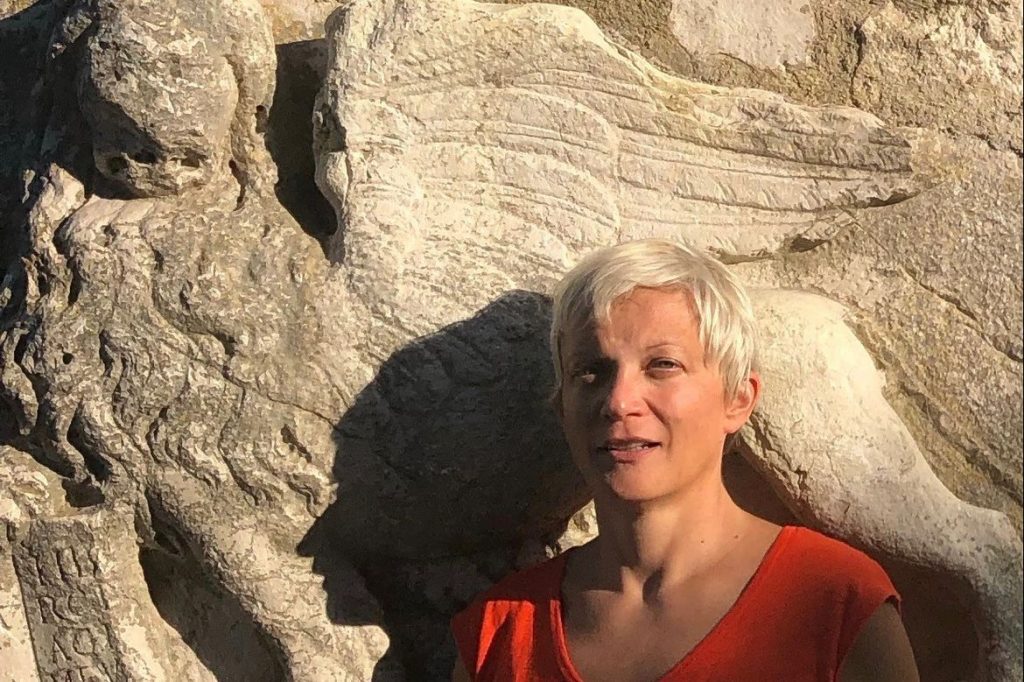Reimagining the scope and approach of the UCLA Center for Early Global Studies
Zrinka Stahuljak embraces the role of ‘fixer’ as she directs the center’s transformation

Zrinka Stahuljak in front of a 15th-century relief of the winged lion of Venice. Each quarter, she guides students through explorations of paintings, sculptures and architecture, encouraging them to find deeper meaning about the people who created them.
| December 15, 2021
Journalists, businesspeople and politicians working in foreign countries often depend on fixers — resourceful, problem-solving guides with a sophisticated grasp of local languages, cultures and customs.
Zrinka Stahuljak has long considered herself a fixer, both literally — she was a wartime interpreter in her native Croatia during the 1990s wars in the former Yugoslavia — and metaphorically, in her role at UCLA.
“I’m fascinated and inspired by the transcultural work of fixers, who ultimately help people make transformative connections,” she says.
It’s in that spirit that Stahuljak has overseen the thoughtful transformation of the UCLA Center for Medieval and Renaissance Studies into the UCLA CMRS Center for Early Global Studies. As the center’s director since 2019, Stahuljak has aimed to honor the center’s illustrious past — founded in 1963, it’s one of the oldest such centers in North America — and ensure its dynamic future.
While the center’s purview will still span the third to the 17th centuries, its new name represents an expanded focus, which now takes a global perspective extending far beyond the Eurocentric view that once defined the field. As part of its new approach, research is centered around five axes: sustainability and repurposing, fluidity and permanence, bodies and performance, conversion and mobility, and communication and archive.
“This collaborative platform allows faculty studying various parts of the globe over almost 1,500 years to exchange effectively from within their fields or work together innovatively across them,” says Stahuljak, a professor of European languages and transcultural studies and of comparative literature.
The transformation makes UCLA’s center one of the first major entities in the field to adopt the new, more inclusive approach, and to employ the new methodologies and interdisciplinary orientations that come with it.
“The key to it all is recognizing and proceeding with the knowledge that none of us is alone in this world,” she says. “That’s something the study of the past can give us: an overwhelming sense of relationality to others who have lived and who will live.”
In the wake of its relaunch, the center already has begun to forge new collaborations with partners from across campus, including scholars at the departments of anthropology, Asian languages and cultures, Near Eastern languages and cultures, and world arts and cultures/dance, the David Geffen School of Medicine at UCLA and the Charles E. Young Research Library.
It’s work worthy of a world-class fixer like Stahuljak, who recently wrote two books on fixers: “Les Fixeurs au Moyen Age: Histoire et Littérature Connectées” (“Fixers in the Middle Ages: Connected History and Literature”), which was published in September by Éditions du Seuil, and “Medieval Fixers: Translation in the Mediterranean (1250–1500),” forthcoming from the University of Chicago Press.
Stahuljak researched and wrote both volumes in 2017 and 2018, when she was a Guggenheim fellow.
Staying connected to Europe and her own past richly informs all Stahuljak does. Born to musician parents who valued education, she grew up with a gift for learning multiple languages, including the two she would later adopt professionally, French and English.
Her time as a wartime interpreter — including a frightening night navigating mountain paths alone after the Croatian–Slovenian border closed — interrupted her college education for a year, but it also taught her much about injustice and the need for an international community of scholarship. Stahuljak went on to earn her master’s degree from the University of Kansas and a doctorate from Emory University; after four years at Boston University, she joined UCLA in 2005.
To open her students’ eyes and intellects and perhaps inspire their empathy, Stahuljak starts each quarter by guiding them through explorations of paintings, sculptures and architecture, encouraging them to find deeper meaning about the people who created them and those who have absorbed them over centuries. Her goal: to help students connect with the subjects they’re studying, no matter the historical distance.
That thoughtful approach carries over to her vision for the Center for Early Global Studies. Even with the campus having resumed in-person instruction, Stahuljak plans to continue offering a range of programs online, too, to maintain the growing global audience it cultivated during the pandemic. She’s also investing in the next generation of scholars, for example by holding manuscript workshops to shepherd junior faculty through the often overwhelming process of producing their first books, and she is directing more funds to support graduate students in both traditional and underrepresented areas of study.
“As a fixer, I see my role as making this a community: a collective platform to empower UCLA’s extraordinary researchers, scholars and teachers,” she says. “My goal is to put myself out there and ask, ‘What do you want to do, and how can I help you make it happen?’”
Stahuljak sees her work relaunching the center as an opportunity to marry her rich understanding of the past with her hopeful view of a humane future for all.
“We cannot understand the present without the past — the contrast allows us to analyze differences, successes and failures and, ideally, to find innovation to build an informed and thoughtful future,” she says. “The CMRS Center for Early Global Studies has an investment in making the past contemporary. These lessons help us do what we fixers always seek to do: invent and make real change.”
